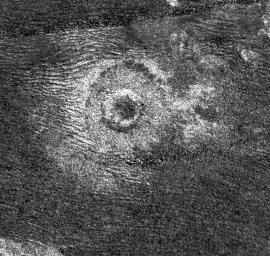
|
A New Crater for Titan
- Click the image above for a larger view
- Full-Res JPEG (1381 x 1310) (485.2 kB)
- Full-Res TIFF (1381 x 1310) (1.8 MB)
Caption:
Impact craters are rare on Titan. Until recently only seven had been identified definitely on Titan, so it was exciting when Cassini's Titan Radar Mapper imaged an eighth impact crater on June 21, 2011. This newly discovered crater is about 25 miles (40 kilometers) in diameter and is surrounded by a continuous blanket of ejecta (material thrown out from the crater) that appears bright to radar and extends roughly 10 to 12 miles (15 to 20 kilometers) beyond the rim. With its well-preserved ejecta and steep inward-facing walls, the new crater resembles the two other freshest known craters on Titan: Sinlap, seen in the radar image of February 2005 ( PIA07368 ), and Ksa, seen in September 2006 ( PIA08737 ) and imaged again in this latest flyby. One difference is that Sinlap and the new crater seem to have flat, largely featureless floors, but Ksa has a bright central peak.
Dunes, visible as dark lines on the left of the image, have been swept toward the crater by the winds of Titan. These dunes have encroached very little onto the bright ejecta, compared to those on Ksa where more than a third of the ejecta blanket on its western edge is covered by dunes.
While Saturn's other moons have many thousands of craters, Titan has very few. One reason is that Titan's dense atmosphere burns up the smaller impacting bodies before they can reach the surface. The craters that do form are often hard to recognize or disappear entirely as they are eroded over time by geological processes such as the wind-driven motion of sand and, possibly, icy volcanism.
This synthetic-aperture radar (SAR) image, centered at 12 degrees north latitude and 45 degrees west longitude, measures 150 miles (242 kilometers) high by 160 miles (257 kilometers) wide, with resolution of about 350 meters per pixel; north is at the top, and the image is illuminated from the bottom. Incidence angle varies from 15 to 25 degrees.
Background Info:
The Cassini-Huygens mission is a cooperative project of NASA, the European Space Agency and the Italian Space Agency. NASA's Jet Propulsion Laboratory, a division of the California Institute of Technology in Pasadena, manages the mission for NASA's Science Mission Directorate, Washington, DC. The Cassini orbiter was designed, developed and assembled at JPL. The radar instrument was built by JPL and the Italian Space Agency, working with team members from the United States and several European countries.
For more information about the Cassini-Huygens mission, visit http://saturn.jpl.nasa.gov/ .
Cataloging Keywords:
| Name | Value | Additional Values |
|---|---|---|
| Target | Titan | |
| System | Saturn | |
| Target Type | Satellite | |
| Mission | Cassini-Huygens | |
| Instrument Host | Cassini Orbiter | |
| Host Type | Orbiter | |
| Instrument | Radar Mapper | |
| Detector | ||
| Extra Keywords | Atmosphere, Crater, Dune, Grayscale, Impact, Radar, Volcano | |
| Acquisition Date | ||
| Release Date | 2011-08-29 | |
| Date in Caption | 2011-06-21 | |
| Image Credit | NASA/JPL-Caltech/ASI | |
| Source | photojournal.jpl.nasa.gov/catalog/PIA14744 | |
| Identifier | PIA14744 | |
